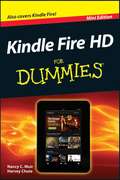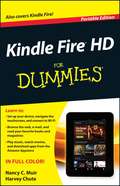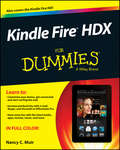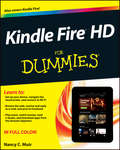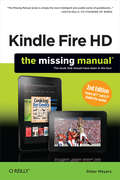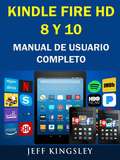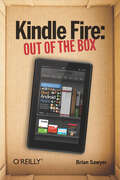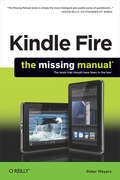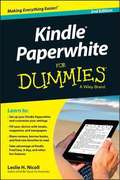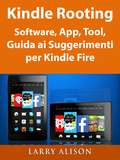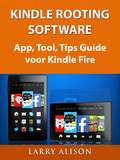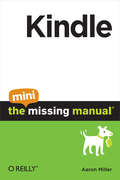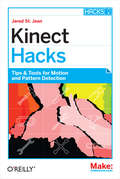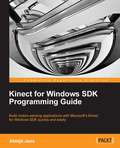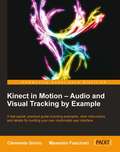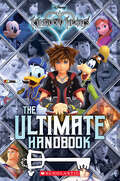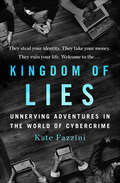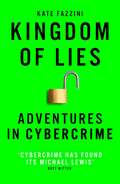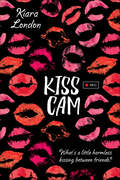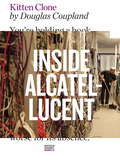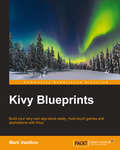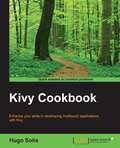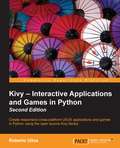- Table View
- List View
Kindle Fire HD For Dummies
by Nancy C. Muir Harvey ChuteMusic, video, e-books, and e-mail -- Kindle Fire HD does it all!Just like your Kindle Fire HD, this little book packs a big punch! This mini guide covers all the Kindle Fire HD basics -- browsing the web and shopping online, connecting to a network, setting up and using e-mail, downloading and running apps, watching videos, keeping up with magazines and newspapers, and even reading books!Open the book and find:Steps for setting up your Kindle Fire HDTips for using the touchscreenHelp transferring photos and documents to the Kindle Fire HDWays to personalize the Silk browserHow to buy and play music and videos
Kindle Fire HD For Dummies
by Nancy C. Muir Harvey ChuteEnjoy movies, apps, e-books, games, and more on the hottest tablet in town -- the Kindle Fire HD!Your Kindle Fire HD is loaded with cool features, and this handy little book helps you get up and running quickly and easily. You'll learn how and where to buy the latest books, music, apps,and periodicals to personalize your Kindle Fire experience. You'll also discover how to set up your e-mail account, browse the web, make Skype calls, and stay connected everywhere you go.New to e-readers? -- get acquainted with the interface, use the Carousel, and set up Wi-FiSafety first -- manage security settings and parental controls to protect your information and your kidsAbout your account -- see what Amazon Prime is all about, take advantage of free cloud storage, and shop the Amazon AppstoreSilky-smooth browsing -- personalize the Silk browser and learn to use its navigation tools to find your way around the webSharing -- find out how to borrow Kindle books and share book information on Facebook and TwitterJust a whisper -- use the cool Whispersync feature with both books and audiobooksOpen the book and find:Hints for using Kindle Fire HD's pre-installed appsTips on using the Options barHow to search, bookmark, or highlight an e-bookAdvice on adjusting settingsWhere to buy books, music, and videoHow to restrict Wi-Fi access with a passwordTop gaming apps for Kindle Fire HD
Kindle Fire HD For Dummies
by Nancy C. MuirMovies, apps, games, e-books, and more - enjoy them all on the hottest device in town - the Kindle Fire HD!From its stunning color touchscreen to its ultrafast speed, the Kindle Fire HD is sparking everyone's interest. This full-color guide will have you blazing through the web, staying entertained with the latest apps and games, watching your favorite TV shows and movies, and, of course, reading magazines, newspapers, and books to indulge all your interests. Whether this is your first tablet or you're upgrading from another device, you'll get to know your Kindle Fire HD and rekindle your love of reading with Kindle Fire HD For Dummies!Covers the Kindle Fire HD and original Kindle FireHelps you navigate the interface, customize your settings, get connected, and take advantage of Amazon CloudShows you how to work with the built-in apps and find new ones to to try out from the Amazon AppstoreExplains how to fill your Kindle Fire with cool stuff - from movies and music to videos, photos, apps, e-books, and moreWalks you through using Amazon's incredibly smooth Amazon Silk web browser to find anything you need online and keep in touch with e-mail, Skype, Facebook, and TwitterLight 'er up and unleash the fun with Kindle Fire HD For Dummies!
Kindle Fire HD For Dummies
by Nancy C. MuirMovies, apps, games, e-books, and more - enjoy them all on the hottest device in town - the Kindle Fire HD! From its stunning color touchscreen to its ultrafast speed, the Kindle Fire HD is sparking everyone's interest. This full-color guide will have you blazing through the web, staying entertained with the latest apps and games, watching your favorite TV shows and movies, and, of course, reading magazines, newspapers, and books to indulge all your interests. Whether this is your first tablet or you're upgrading from another device, you'll get to know your Kindle Fire HD and rekindle your love of reading with Kindle Fire HD For Dummies! Covers the Kindle Fire HD and original Kindle Fire Helps you navigate the interface, customize your settings, get connected, and take advantage of Amazon Cloud Shows you how to work with the built-in apps and find new ones to to try out from the Amazon Appstore Explains how to fill your Kindle Fire with cool stuff - from movies and music to videos, photos, apps, e-books, and more Walks you through using Amazon's incredibly smooth Amazon Silk web browser to find anything you need online and keep in touch with e-mail, Skype, Facebook, and Twitter Light 'er up and unleash the fun with Kindle Fire HD For Dummies!
Kindle Fire HD: The Missing Manual Second Edition
by Peter MeyersAmazon’s Kindle Fire HD combines the most popular e-reader and tablet features in one sleek package, and with this entertaining guide, you’ll master everything the Fire has to offer. With loads of illustrations, step-by-step instructions, and savvy tips, you’ll learn how to manage your media library in the cloud, find the coolest apps, and make the most of your Kindle Fire experience—no matter which model you choose.The important stuff you need to know:Read all about it. Find ebooks and newspapers in the Kindle Store, and add your own books and magazines.Use great new features. Discover Amazon’s X-Ray service, and parental controls for individual users.Take in a show. Watch movies and TV series, and display your photos and videos.Go online. Browse the Web and manage email with Wi-Fi and 4D LTE.Fill up your jukebox. Listen to your favorite music from Amazon and iTunes.Load up on apps. Get popular games, guides, and references with Amazon’s Apps for Android.Get to work. Read PDFs, Word files, Excel spreadsheets, and other docs.
Kindle Fire Hd 8 Y 10 Manual De Usuario Completo
by Jeff KingsleyUna guía paso a paso sobre cómo sacar el máximo provecho de tu Kindle HD 8 10 y todos los demás dispositivos * Admite todos los dispositivos Kindle Fire * Si no, la mejor característica del Kindle Fire Stick es la capacidad de fuga. Esto te permitirá acceder a cualquier contenido que desee, como programas de televisión, aplicaciones, música y películas. Aquí tienes lo que obtendrás: -Combinación de Android y Kindle -Gestionar tu cuenta Kindle -Lectura y descarga de libros -Inicio e instalación de aplicaciones -Amazon Prime -Música -Videos -Acceso a la Web -Emisión de correo electrónico -Ajustar el dispositivo -Meno -Opciones -Actualización -Solución de problemas -Configuraciones de seguridad -Display Settings + MUCHO MÁS! -> Desplázate hasta la parte superior de la página y haz clic en agregar al carro para comprar al instante
Kindle Fire: Out of the Box
by Brian SawyerWhen you open the box for your brand-new Kindle Fire, you'll find the hottest 7-inch tablet to hit the market, a power adapter, and a "Quick Start Guide" that tells you how to turn it on. But to really take advantage of all the content and features the device has to offer, you'll need a little more. Kindle Fire: Out of the Box gets you up and running beyond the first "Slide to unlock" screen to unlock all of your media from the cloud in the palm of your hand.Whether your media library lives in Amazon Cloud Drive or on your device, the Fire gives you immediate access to all of it, wherever you are, as long as you know where to find it and how to consume it. With Kindle Fire: Out of the Box, you'll jump right in to reading full-color magazines, newspapers, newly enhanced ebooks, and your own personal documents. Quickly download music from your Amazon Cloud Drive or new music from the Amazon MP3 store to listen offline, and get instant, unlimited access to streaming of over 10,000 popular movies and TV shows. And go beyond your own media to experience integrated email, games, Android apps from the Amazon App Store, and ultra-fast web browsing with the revolutionary, cloud-accelerated Silk browser.This intuitive, easy-to-follow ebook opens the world of possibilities made possible by the Kindle Fire, right out of the box.
Kindle Fire: The Missing Manual
by Peter Meyers<p>Enter a bright new world of entertainment with Amazon’s red hot tablet. This guide lights the way with lots of illustrations and step-by-step instructions for browsing the Web, emailing, playing games, and viewing books, movies, and magazines in blazing color. Learn how to manage your media library on the Fire and in the cloud—and where to find the coolest apps. Everything you need is right here.</p>
Kindle Fire: The book that should have been in the box
by Peter MeyersEnter a bright new world of entertainment with Amazon’s red hot tablet. This guide lights the way with lots of illustrations and step-by-step instructions for browsing the Web, emailing, playing games, and viewing books, movies, and magazines in blazing color. Learn how to manage your media library on the Fire and in the cloud—and where to find the coolest apps.Note: This first edition of Kindle Fire: The Missing Manual covers only the original Kindle Fire sold between November, 2011 and September, 2012. For later models, please see Kindle Fire: The Missing Manual, 2nd edition.The important stuff you need to know:Read all about it. Find, load, and read a variety of ebooks, magazines, and newspapers.Go online. Browse the Web and manage email with a secure Wi-Fi connection.Put on a show. Watch movies and TV series, and showcase your photos and videos.Fill up your jukebox. Listen to your favorite music from Amazon and iTunes.Load up on apps. Get popular games, guides, references, and more with Amazon’s Apps for Android.Take your briefcase. Read PDFs, Word files, Excel spreadsheets, and other docs.
Kindle Paperwhite For Dummies
by Leslie H. NicollGet the inside story on the all-new Kindle Paperwhite with help from For DummiesIt reads like a book, but it's so much more. The Kindle Paperwhite is the ultimate e-reader, and this updated edition of Kindle Paperwhite For Dummies is your ultimate guide to getting more from this one-of-a-kind device. You'll learn to set up your Paperwhite, adjust the font to your liking, find your favorite books, magazines, and newspapers, and sync your Kindle content across devices before moving on to new Paperwhite features like Kindle FreeTime, Goodreads integration, Vocabulary Builder, In-line Footnotes, and Page Flip.Shows you how to navigate the touchscreen, work with the Paperwhite icons, connect via Wi-Fi, customize text size, and get personal recommendationsExplains how to purchase and download books, try out sample chapters before you buy, subscribe to magazines and newspapers, and find free books or books that can be borrowed from the Kindle Lending LibraryTells you how to take advantage of cool Kindle Paperwhite features like encouraging reading with Kindle FreeTime, learning new words with Vocabulary Builder, translating passages into other languages, sharing your recommendations with other readers via Goodreads, and delving deeper into a book's characters and content with X-RayIt's prime time you got to know the powerful, popular Paperwhite with help from Kindle Paperwhite For Dummies, 2nd Edition.
Kindle Rooting Software, App, Tool, Guida ai Suggerimenti per Kindle Fire
by Larry AlisonGuida passo dopo passo su come eseguire il root sui dispositivi kindle. La migliore caratteristica dei dispositivi kindle è forse la possibilità di eseguirne i root. Questo ti permetterà di accedere a qualsiasi contenuto che desideri, come programmi TV, app, musica e film. Ecco cosa otterrai: •Funziona per ogni dispositivo kindle •Informazioni sul rooting •Come effettuare il root sul tuo kindle •Risoluzione dei problemi •Come aggiungere Google Play •Goditi l'accesso ad app, film, musica e programmi TV. --> Scorri fino alla parte superiore della pagina e fai clic al carrello per acquistarlo immediatamente Disclaimer: Questo autore e i proprietari del copyright non fanno alcuna promessa o garanzia circa l'adeguatezza dei contenuti di questo libro e declina espressamente la responsabilità per errori od omissioni nei contenuti all'interno. Questo è solo un prodotto di riferimento.
Kindle Rooting Software, App, Tool, Tips Guide Voor Kindle Fire
by Larry AlisonEen stapsgewijze handleiding over het crawlen van Kindle-apparaten Als niet de beste eigenschap van de Kindle-apparaten de mogelijkheid is om ze te rooten. Hiermee krijgt u toegang tot alle gewenste inhoud, zoals tv-programma's, apps, muziek en films. Hier is wat je krijgt: -Werkt voor elk Kindle-apparaat -Over het Rooten -Wortel je Kindle -Problemen oplossen -Hoe om Google Play toe te voegen - Geniet van toegang tot apps, films, muziek en tv-shows -> Scroll naar de bovenkant van de pagina en klik op toevoegen aan winkelwagen om direct te kopen Disclaimer: Deze auteur en / of rechthebbende (n) doen geen uitspraken, beloftes of garanties over de juistheid, volledigheid of toereikendheid van de inhoud van dit boek en ontkent uitdrukkelijk aansprakelijkheid voor fouten en weglatingen in de inhoud van dit boek. Dit product is alleen voor referentie gebruik.
Kindle Software de Root, App, Ferramenta e Dicas - Guia para Kindle Fire
by Larry AlisonUm guia passo a passo sobre como realizar o root no dispositivo Kindle A capacidade de root no Kindle é um recurso extraordinário, isso permitirá que você tenha acesso a qualquer conteúdo que você queira de forma ilimitada, como programas de TV, aplicativos, músicas e filmes. Aqui está a lista do que você vai conseguir fazer com esse guia: -Trabalhar com qualquer dispositivo Kindle -Aprender tudo sobre root -Como fazer root no seu Kindle -Resolver seus problemas -Adicionar o Google Play -Desfrutar de acessos a aplicativos, filmes, músicas e programas de TV. -> Role até o topo da página e clique em adicionar ao carrinho para comprar instantaneamente Aviso Legal: Este autor e detentor de direitos não fazem reivindicações, promessas ou garantias sobre a exatidão, integridade ou aplicação do conteúdo deste livro, e se isenta expressamente da responsabilidade por erros e omissões nos conteúdos nele contidos. Este produto é apenas para referência. Gênero: COMPUTADORES / Hardware / Dispositivos Portáteis Gênero Secundário: COMPUTADORES / Hardware / Geral Língua: Português Brasil Contagem de palavra: 1.400 (Português) Links de livros: Amazon
Kindle: The Mini Missing Manual
by Aaron MillerSo, you have your Kindle and are ready to start reading. Great! But did you know that you can play music on the Kindle while you are reading that new bestselling novel? How about sharing your thoughts about the book with friends via Facebook and Twitter? More than just an e-reader, Amazon's popular device lets you do those things and much more. You can create a custom calendar to help plan your day or remember your mom's birthday, calculate the tip at your favorite restaurant, and waste a little time and have fun playing games or surfing the web. Check out Kindle: The Mini Missing Manual to learn how to get the most out of your device.
Kinect Hacks: Tips & Tools for Motion and Pattern Detection
by Jared St. JeanCreate your own innovative applications in computer vision, game design, music, robotics, and other areas by taking full advantage of Kinect’s extensive interactive, multi-media platform. With this book, you get a step-by-step walkthrough of the best techniques and tools to come out of the OpenKinect project, the largest and most active Kinect hacking community.Learn dozens of hacks for building interfaces that respond to body movements, gestures, and voice, using open source toolkits such as openFrameworks, the Processing IDE, and OpenKinect driver library. Whether you’re an artist, designer, researcher, or hobbyist, this book will give you a running start with Kinect.Set up a development environment in Windows 7, Mac OSX, or UbuntuBuild special effects apps with tools such as Synapse and CinderCreate gestural interfaces to integrate and control digital music componentsCapture the realistic motions of a 3D model with NI mate, Blender, and AnimataDesign gesture-based games with the ZigFu SDKRecreate the dimensions of any room in realtime, using RGBDemoUse gestures to navigate robots and control PC interfaces
Kinect for Windows SDK Programming Guide
by Abhijit JanaThis book is a practical tutorial that explains all the features of Kinect SDK by creating sample applications throughout the book. It includes a detailed discussion of APIs with step-by-step explanation of development of a real-world sample application.If you are looking to develop motion sensing, speech recognizing applications with Kinect, then this book is for you,This book uses C# and WPF in the examples, so you need to know the basics of C# and WPF. You don't have to know anything about Kinect for Windows SDK.
Kinect in Motion – Audio and Visual Tracking by Example
by Massimo Fascinari Clemente GiorioThe book includes a series of step-by-step illustrated tutorials supported by detailed explanations for building a multimodal user interface based on Kinect for Windows.Kinect in Motion - Audio and Visual Tracking by Example is great for developers new to the Kinect for Windows SDK, and who are looking to get a good grounding in how to master video and audio tracking. It's assumed that you have some experience in C# and XAML already.
Kingdom Hearts: The Ultimate Handbook
by Conor LloydA guide to some of the most important characters in the Kingdom Hearts series. Includes fold-out poster!From Sora and Xehanort to Donald, Goofy, King Mickey, and a wide variety of other characters, this handbook provides an overview on some of the most iconic characters in this incredible gaming franchise. Plus, it comes with a fold-out poster! It's a must-have for fans of the Kingdom Hearts series.
Kingdom of Lies: Unnerving Adventures in the World of Cybercrime
by Kate Fazzini“Wow. Kate Fazzini is the rare top-level reporter who can make you see, smell and feel a hidden world, not just understand it. Cybercrime (and security) has found its Michael Lewis.” —Bret Witter, co-author of the #1 NYT bestseller The Monuments MenOne of BookRiot's "50 of the Best Books to Read This Summer"In the tradition of Michael Lewis and Tom Wolfe, a fascinating and frightening behind-the-scenes look at the interconnected cultures of hackers, security specialists, and law enforcementA 19-year-old Romanian student stumbles into a criminal ransomware ring in her village. Soon she is extorting Silicon Valley billionaires for millions--without knowing the first thing about computers.A veteran cybersecurity specialist has built a deep network of top notch hackers in one of the world’s largest banks. But then the bank brings in a cadre of ex-military personnel to “help.” A cynical Russian only leaves his tiny New Jersey apartment to hack sports cars at a high performance shop in Newark. But he opens his door to a consultant who needs his help. A hotel doorman in China once served in the People’s Army, stealing intellectual property from American companies. Now he uses his skills to build up a private side-business selling the data he takes from travelers to Shanghai’s commercial center. Kingdom of Lies follows the intertwined stories of cybercriminals and ethical hackers as they jump from criminal trend to criminal trend, crisis to crisis. A cybersecurity professional turned journalist, Kate Fazzini illuminates the many lies companies and governments tell us about our security, the lies criminals tell to get ahead, and the lies security leaders tell to make us think they are better at their jobs than they are.Like Traffic set in the cybercrime world, Kingdom of Lies is as entertaining as it is eye opening.
Kingdom of Lies: Unnerving adventures in the world of cybercrime
by Kate FazziniWould you say your phone is safe, or your computer? What about your car? Or your bank? There is a global war going on and the next target could be anyone – an international corporation or a randomly selected individual. From cybercrime villages in Romania to intellectual property theft campaigns in China, these are the true stories of the hackers behind some of the largest cyberattacks in history and those committed to stopping them. You&’ve never heard of them and you&’re not getting their real names. Kate Fazzini has met the hackers who create new cyberweapons, hack sports cars and develop ransomware capable of stopping international banks in their tracks. Kingdom of Lies is a fast-paced look at technological innovations that were mere fantasy only a few years ago, but now make up an integral part of all our lives.
Kiss Cam
by Kiara LondonIn Kiss Cam, teen author Kiara London asks, what's a little harmless kissing between friends?Juniper, Jasper, and Lenny have been friends forever and co-own a vlog channel called WereVloggingHere. Their fans are huge "shippers" who believe that Juniper and Jasper are perfect for each other, and, despite warnings from friends and family, a simple Truth-or-Dare inspired kiss soon spirals out of control into a whole new world of making out and surprise kisses. Juniper and Jasper's relationship begins to shift. But as fan requests for different "Kiss Cam" segments keep pouring in, Juniper puts her worries aside and convinces herself that it doesn't mean anything. After all, it's just kissing… right?In this adorably fun, fresh, and modern contemporary romance, a trio of vloggers push the boundaries of their friendship by giving in to fan requests for a "Kiss Cam" segment.
Kitten Clone
by Douglas CouplandDouglas Coupland, one of the world's biggest cultural brains, takes an inside look at the global company that keeps us connected, and wonders what all that connectivity is doing to our brains and our sense of ourselves as humans. The incomparable Douglas Coupland reports from inside the corporate offices and science labs of Alcatel-Lucent, a globally influential business whose work is largely unknown to consumers. "Were it to vanish tomorrow," he writes, "our modern world would grind to a halt. The Internet would implode--your Internet would implode." Although his examination of the company is playful and fascinating in its own right, Coupland's account is driven by his thoughtful reflections on the larger cultural and sociological significance of the transformative information technology Alcatel works on: fiber wire, microprocessors, the Internet and mobile technologies. And by a larger meditation about what the Internet is doing to us as it relentlessly colonizes the planet, and our brains. Like Coupland's best work, Kitten Clone is a wildly entertaining yet penetrating encounter with the technological and cultural forces that surround us. And also a surprising and unique exploration of a possible future.From the Trade Paperback edition.
Kivy Blueprints
by Mark VasilkovThis book is intended for programmers who are comfortable with the Python language and who want to build desktop and mobile applications with rich GUI in Python with minimal hassle. Knowledge of Kivy is not strictly required--every aspect of the framework is described when it's first used.
Kivy Cookbook
by Hugo SolisEnhance your skills in developing multi-touch applications with Kivy About This Book * Create most diverse apps and learn how to distribute them with the help of the Kivy framework * Explore Kivy API to develop user interfaces and control multi-touch events * Step-by-step recipes that provide deeper understanding of the Kivy 1.9.0 framework * Build and use your own events, widgets and gestures using features and tools in Kivy Who This Book Is For This book is intended for developers who want to use features of the Kivy framework and develop multi-touch applications. Prior experience with Kivy is not required, although familiarity with Python is expected. What You Will Learn * Access widgets defined inside Kv language in your Python code * Handle Kivy events to control widgets, touches, the mouse, the keyboard, and animations * Recognize touch shapes and detecting multi-tapping * Create custom events and declare properties * Organizing your layouts while working with the ActionBar * Store and retrieve the coordinate space context * Create your own shader and render in a framebuffer * Leverage Factory objects, multi-touch in iOS and multi-touch in Android In Detail Kivy is an open-source Python library for rapid development of applications that make use of innovative user interfaces, such as multi-touch apps. It is a promising Python framework to develop UI and UX apps in a cross-platform environment, under the Python philosophy. Kivy Cookbook is a practical book that will guide you through the Kivy framework to develop apps and get your apps ready for distribution in App Store and Android devices. You will start off with installing Kivy and building your interfaces. You will learn how to work the accelerometer and create custom events. Then, you will understand how to use the basics, buttons, labels and text inputs and manipulate the widget tree. Next, you will be able to work with manipulating instructions, create an atlas and layouts. Moving on, you will learn packing for Windows and packing for iOS, and use TestDrive. By the end of the book, you will have learnt in detail the relevant features and tools in Kivy and how to create portable packages to distribute your apps in the most used platforms. Style and approach This is an easy-to-follow practical guide packed with graspable recipes that cover important tasks to be performed while developing multi-touch applications with Kivy. All the code used in each recipe is explained in detail.
Kivy – Interactive Applications and Games in Python - Second Edition
by Roberto UlloaIf you are a Python developer who wants to create exciting and dynamic UI/UX applications that are compatible with multiple platforms, then this is the book for you. No prior experience with Kivy is required, although you should be familiar with Python and have a fair understanding of software engineering concepts such as inheritance, classes, and instances.
